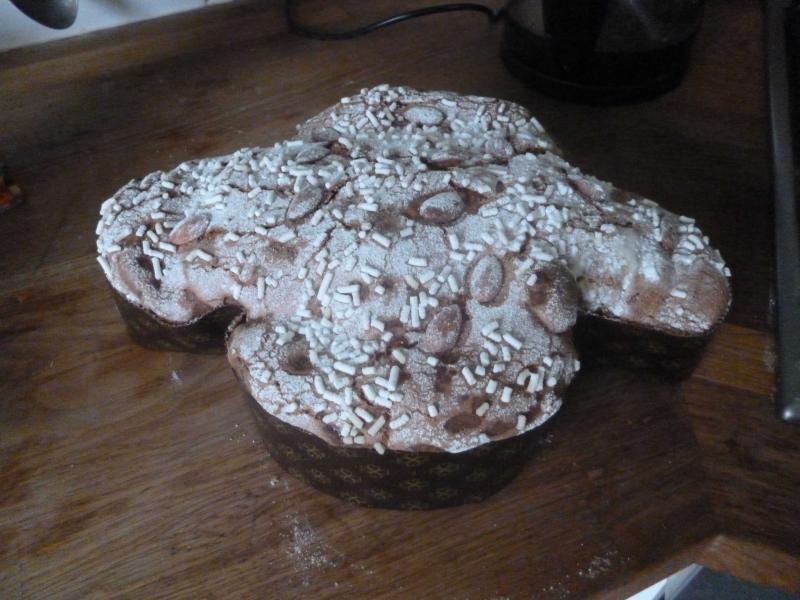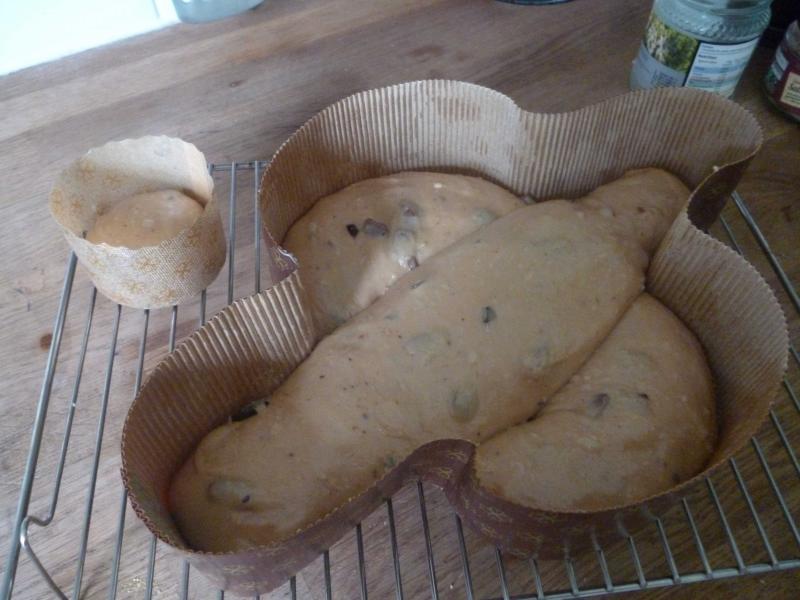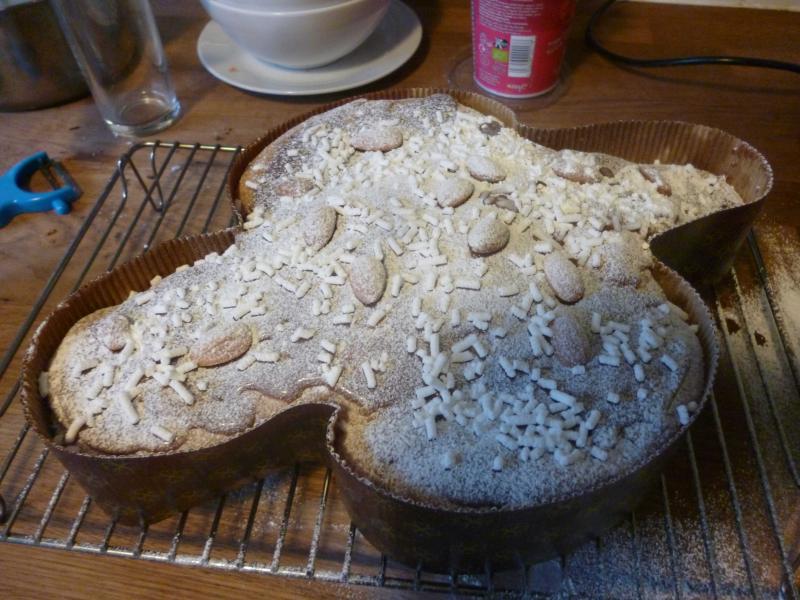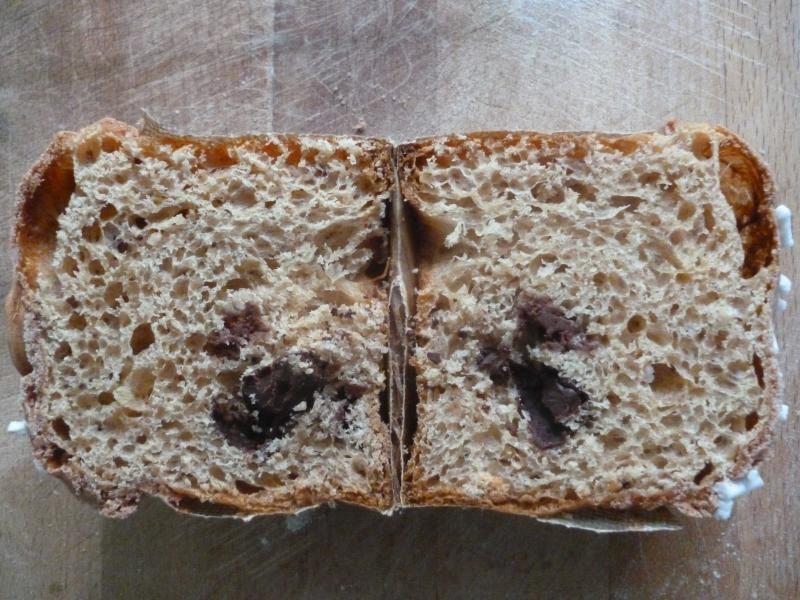Hi bakers everywhere!
I made this a few weeks ago but have only had the chance to post it now. I took the recipe from Cresci, by Massari and Zoia. In the book it's for a panettone but I thought I'd try to make it in the form of a colomba because it was around Easter and I still had a few colomba cases left to use :)

This is a very unusual panettone recipe in the all the flour goes into the first dough. The traditional method is to split the flour between the two stages. I'm not quite sure what the benefits of this are (allowing for more autolysis) but there are a few recipes in the book where this happens. I'm pretty certain that these "non-traditional" formulae are associated with Achille Zoia. I've been working on his panettone paradiso (another flour-all-in-one recipe) on-and-off now for over a month and I kid you not, I've only made it work once, despite about 15 attempts!! Fool that I am, the one time it worked I didn't take any photos, but the crumb was the softest and moistest of any panettone I've ever had, so I'm determined to persever. But back to the colomba...
The recipe calls for hazelnut paste and gianduia amara. I bought the hazelnut paste online (very expensive) because I don't have the equipment to make a truly smooth paste at home. The gianduia I made myself, using the following recipe (in grams). I took amara here to mean the use of dark chocolate rather than milk. I used Amedei toscano black - a really delicious, and Italian, chocolate.
hazelnut paste 50
dark chocolate 70% 20
cacao butter 6
icing sugar 50
melt the chocolate and cacao butter together and then blend in the icing sugar and paste. It's important to stir constantly and drop the temp as quickly as possible to 26C to prevent it from separating. I took this recipe from Valrhona's cooking with chocolate book.
I made the first impasto at about 10pm so that I could go to bed and rise the next day with it ready.
sugar 79
water 177
hazelnut paste 32
very strong flour 316
Italian sweet starter 63
butter 63
I left the flour, sugar and water to autolyse for half an hour and then added the other ingredients, working it until the dough was stringy.
The next morning it had tripled in volume (12 hours precisely) so I reworked it with the following:
sugar 47
honey 32
butter 47
gianduia (melted) 47
hazelnut paste 32
yolk 73
salt 2.5
vanilla quarter of a pod
water 9
milk chocolate 62
dark chocolate 47
take 991 of the impasto and add chocolate pieces. For the milk choc I used Valrhona's Jivara, and a mix of Amedei toscano black and Valrhona's Manjari for the dark.
My last attempt at forming a colomba hadn't been a success, so taking inspiration from thefreshloaf, I decided to fold and stretch it repeatedly until I had a nice tight ball. I let this rest for an hour and then repeated the process, before putting it into the shape. I was much happier with the shaping this time, the dough had a better, tighter skin on it.

I had just enough dough left over to make a "panettoncino" of about 85g.
About 6 hours later (held at c. 30C) it was ready to go in the oven. I glazed it, covered it was sugar granules and almonds, and then dusted it was icing sugar.

My glaze this time was a little thicker than I've made it before - too thick I think, even though I followed my usual recipe. I should have added a tiny bit more egg white. It was just a tad too thick to be easily spreadable. In the oven then for 50 minutes at 170C. I didn't bother with steam because I was worried about the icing sugar. I'm not sure it made any difference.
Oven spring was enormous. The top photo doesn't really do it justice. I doesn't show just how much over the edge of the form it is. I slightly crushed it with my hand when I was turning it upside down (idiot!!!) but apart from a crack on the surface, it popped right back out when it was hanging during cooling.
The colomba itself was a present, so the only crumb shot I have is from the panettoncino. I think there was just a little too much impasto in the pirottino... BakeryBits.co.uk markets them as 100g cases, but I think even 80g is too much if you are using them for a panettone. I think perhaps 70g might have been better.

Well, my conclusions...
I tasted both the baby panettone and the colomba and I was very... disappointed!!! There was zero(!!) taste of hazelnut from it. Zero!!! The hazelnut paste I used was professional quality (it certainly had a professional price) but it didn't even leave a trace of flavour in the finished product. The photo in Cresci implies a deep brown crumb, but my crumb looks more beige. I didn't know what industrial strength paste Zoia must be using to achieve any flavour or colour on this one. The crumb itself, although very shreddy, as it should be, was also quite dry. The driest of all the panettone I've made so far. All I can say is thank God I used good quality chocoalte, because otherwise the entire thing would have been very uninteresting.
It's a great shame, because I'd been looking at the recipe for ages, thinking it would be great. Where is the hazelnut flavour?!?!? Another thing I've noticed is the how much growth in the colomba is lost to sideways motion. The circular shape of the panettone form is very strong, so all the growth is directed upwards. The colomba seems structurally weaker, you can see how the sides have bulged out and become distored.
I need a break from panettone making for the moment... the repeated disasters with the panettone paradiso have knocked my confidence terribly. Hopefully a break will allow me to... what? I'm not giving up on it though. I refuse to be beaten by a bit of flour, butter and egg!
David